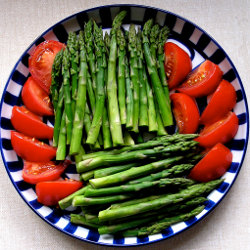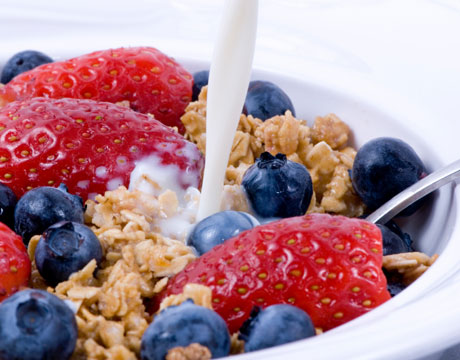Why we have such a hard time eating right and easy fixes to get your Diet on track
In a new survey, 36 percent of women said they regularly have strong cravings for bakery goodies like doughnuts.
 We know it’s not always easy to eat right and order the grilled chicken on greens with the dressing on the side when you’re dying to sink your teeth into a juicy burger and fries. We also know that life often gets in the way of healthy eating – maybe your family refuses to eat veggies or your budget is more Walmart than Whole Foods. According to ShopSmart new national poll, these are just two of the many reasons that it’s so tough to eat healthy.
We know it’s not always easy to eat right and order the grilled chicken on greens with the dressing on the side when you’re dying to sink your teeth into a juicy burger and fries. We also know that life often gets in the way of healthy eating – maybe your family refuses to eat veggies or your budget is more Walmart than Whole Foods. According to ShopSmart new national poll, these are just two of the many reasons that it’s so tough to eat healthy.
Top reasons for not eating healthy
See how your excuses stack up against more than 1,000 women in the new national ShopSmart poll.
57% Healthy foods are more expensive
47% Social settings present too many temptations
39% Life is too short; I want to enjoy what I eat
33% It’s hard to find healthy options when eating out
29% I don’t’ have time to prepare healthy meals
25% My family prefers less healthy choices
20% Unhealthy habits are too hard to change
18% Healthy foods don’t satisfy my appetite
13% I’m not sure which foods are healthy
Almost half of women surveyed say they could be eating better or feel really bad about their eating habits.
The excuse Healthy foods are too expensive. The fix Shop for the nutrition deals.
Yes, healthy food can be more expensive but it doesn’t have to be. Some of the most nutritious foods are among the cheapest in terms of nutritional bang for your buck. Think fiber-rich grains like barley and quinoa, antioxidant-packed cabbage and tomato sauce. If meat is the biggest chunk of your food budget, plan a few weekly meals around cheaper proteins such as beans, eggs, skinless chicken thighs, and canned salmon. Recipe websites, including Allrecipes.com and MyRecipes.com, can give you inspiration. (Healthy convenience foods are a time-saving option; though they’re more expensive, they may be worth it). Buying fresh produce in season also saves money. Or head to the freezer case. Frozen produce is just as healthy as fresh and it’s often cheaper.
The excuse Social settings are too tempting. The fix Plan ahead.
 There’s nothing wrong with splurging in moderation. If you’re going to a party, pick and choose what’s important to you – maybe have drinks or a couple of hors d’oeuvres before dinner and skip dessert, or vice versa. If you still end up overeating, let it go and get right back on the healthy track the next day. Have your usual breakfast and exercise a little more to burn extra calories.
There’s nothing wrong with splurging in moderation. If you’re going to a party, pick and choose what’s important to you – maybe have drinks or a couple of hors d’oeuvres before dinner and skip dessert, or vice versa. If you still end up overeating, let it go and get right back on the healthy track the next day. Have your usual breakfast and exercise a little more to burn extra calories.
The excuse Life is too short. The fix Give yourself portioned treats
You don’t have to eat perfectly all of the time. Everyone should enjoy what they eat – and eat without guilt. The trick is portion control. You can still relish the high-fat foods you love by down-sizing a serving of, say, pizza, lamb chops, or chocolate cake. As long as the biggest share of your diet is made up of healthy stuff – fruits, veggies, whole grains, nuts, lean protein, and 10 percent of your daily calories for things that don’t fit the healthy profile. Experts suggest cranking up the enjoyment factor by building in a 150- to 200-calorie treat every day. That translates to half a cup of ice cream, half a chocolate bar, a glass of wine, or other goodies.
The excuse It’s hard to find healthy options when eating out. The fix Before you go, hit the Internet.
Go online and research the menu to find healthy dishes before you walk into the restaurant. Many chains, including Olive Garden, Panera Bread, and PF. Chang’s post nutrition info so that you’ll know to pick the linguine with marinara sauce at Olive Garden (430 calories) over the eggplant parmigiana (850 calories) even before you see the menu. If calorie info isn’t available, go with grilled fish or chicken. I’s usually leaner and has fewer calories than, say, oily stir-fries or cheesy pasta dishes. Pick a baked potato or a veggie over a side of fries or mashed potatoes. And ask for salad dressings and sauces on the side.
The excuse I don’t have time to prepare healthy meals. The fix Try time-saving shortcuts.
Look for recipes with five or fewer ingredients. Go to Foodily or FoodNetwork and search for “live-ingredient recipes”. Pre-prepped ingredients also save time. Choose things you can mix and match, such as skinless rotisserie chickens, bottled sauces, and trimmed and cut-up veggies. Don’t like to cook? Change your image of what cooking means. Make breakfast for dinner by scrambling eggs with broccoli or spinach and servings with whole-grain toast.
The excuse My family prefers less healthy choices. The fix Make tiny tweaks.
 Don’t let picky eaters bring you down, encourage them to follow your example. The trick is to start slowly and give everybody in the family a day of the week to pick dinner. If they’re used to eating less healthful food, balance the less healthy choices with better ones. Say your husband wants barbecued chicken and mac and cheese. That’s fine, but serve it with green beans or broccoli. Or get in the habit of making a big, leafy salad to go with every dinner. When it’s your turn to pick the meal, team something healthy with a food that you know everyone loves.
Don’t let picky eaters bring you down, encourage them to follow your example. The trick is to start slowly and give everybody in the family a day of the week to pick dinner. If they’re used to eating less healthful food, balance the less healthy choices with better ones. Say your husband wants barbecued chicken and mac and cheese. That’s fine, but serve it with green beans or broccoli. Or get in the habit of making a big, leafy salad to go with every dinner. When it’s your turn to pick the meal, team something healthy with a food that you know everyone loves.
The excuse Unhealthy habits are too difficult to change. The fix Keep trying.
How you fix and present healthy foods will have a lot to do with whether you like them enough to make them a habit. And if you don’t enjoy something the first time, you might like it the next time. It can take up to 20 exposures to a new food for someone to accept it. To give foods you’re not crazy about a chance, experiment with cooking techniques and seasonings. Maybe you’ll like asparagus (or any vegetable, for that matter) better grilled than steamed or lentils dressed up with spices in the curry family. It helps to pair something you like with a food you’re not sure about. For example, sauté diced carrots and apples (or other familiar favorites) with chopped turnips and parsnips (or other healthy new foods).
The excuse Healthy foods don’t satisfy me. The fix Fuel up to fill up.
 You won’t’ feel satisfied if you’re eating too little or simply loading up on fruits and vegetables. They can make you feel full temporarily, but it’s a fleeting sense of fullness and satisfaction. The solution: Add a bit more protein and fat to your diet and you’ll feel full longer. You can do that with sensible snacks that pair produce and protein – a handful of nuts and an apple or celery with peanut butter – to take the edge off hunger between meals. And make sure your salad bowl contains a filling mix of greens, healthy fats (avocado or nuts0, and lean protein 9grilled chicken, beans, or hard-boiled egg).
You won’t’ feel satisfied if you’re eating too little or simply loading up on fruits and vegetables. They can make you feel full temporarily, but it’s a fleeting sense of fullness and satisfaction. The solution: Add a bit more protein and fat to your diet and you’ll feel full longer. You can do that with sensible snacks that pair produce and protein – a handful of nuts and an apple or celery with peanut butter – to take the edge off hunger between meals. And make sure your salad bowl contains a filling mix of greens, healthy fats (avocado or nuts0, and lean protein 9grilled chicken, beans, or hard-boiled egg).
The excuse I’m not sure which foods are healthy. The fix Follow the 50percent rule.
Keep this in mind when you shop: your cart should contain 50 percent produce (fresh, canned, or frozen), 25 percent lean protein (eggs, beans, fish, chicken, leaner cuts of meat, and low-fat dairy foods), and 25 percent whole grains (breads, wraps, pasta, and cereal). Read labels on packaged foods, and compare serving size, calories, saturated fat, sodium, and fiber in similar products to choose the best. And don’t be swayed by foods that sound healthy but aren’t.

